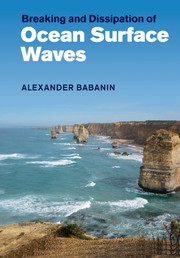Book contents
- Frontmatter
- Contents
- Preface
- 1 Introduction
- 2 Definitions for wave breaking
- 3 Detection and measurement of wave breaking
- 4 Fully nonlinear analytical theories for surface waves and numerical simulations of wave breaking
- 5 Wave-breaking probability
- 6 Wave-breaking severity
- 7 Energy dissipation across the wave spectrum
- 8 Non-dissipative effects of breaking on the wave field
- 9 Role of wave breaking in the air–sea interaction
- 10 Conclusions. What else do we need to know about wave breaking?
- References
- Index
7 - Energy dissipation across the wave spectrum
Published online by Cambridge University Press: 25 October 2011
- Frontmatter
- Contents
- Preface
- 1 Introduction
- 2 Definitions for wave breaking
- 3 Detection and measurement of wave breaking
- 4 Fully nonlinear analytical theories for surface waves and numerical simulations of wave breaking
- 5 Wave-breaking probability
- 6 Wave-breaking severity
- 7 Energy dissipation across the wave spectrum
- 8 Non-dissipative effects of breaking on the wave field
- 9 Role of wave breaking in the air–sea interaction
- 10 Conclusions. What else do we need to know about wave breaking?
- References
- Index
Summary
In previous chapters, we have considered in some detail dissipation of wave energy in the course of individual wave-breaking events. This makes clear physical sense as breaking is an intermittent rather than continuous process, and the breaking rates in realistic circumstances are of the order of a few percent. That is, only a few waves out of a hundred break at any given spot or any given time, and that is sufficient to keep the energy balance in a wave system that experiences a consistent and uninterrupted energy input from the wind.
As discussed in Chapter 6 and throughout the book, it is often the case that more than one wave is affected in a single breaking occurrence. The dynamics of these waves is locked and coupled in many ways, and as far as the wave-energy dissipation is concerned, these energy losses are impossible to separate. Therefore, it usually makes sense to look at the properties of the wave group where the breaking took place rather than investigate the dynamics of some individual wave.
One way or another, there are no theoretical or even experimental approaches that would allow us to describe the breaking-dissipation process as such, in terms of some decay rate, as, for example, gradual energy decline due to the action of viscosity in fluid flows. First of all, unlike most if not all other dissipation causes, breaking dissipation has a start and an end.
- Type
- Chapter
- Information
- Breaking and Dissipation of Ocean Surface Waves , pp. 232 - 321Publisher: Cambridge University PressPrint publication year: 2011



